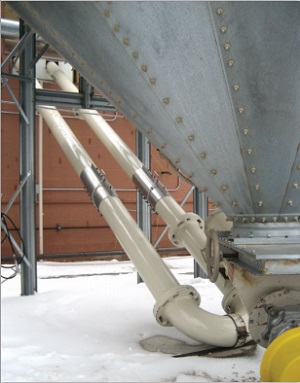
CHALLENGEA pelletized fuel manufactuer was spending time and effort maintaining a conveyor that also created fines and dust. CUSTOMERFiber By-Products Corporation INDUSTRYPelletized Fuel Manufacturer |
BUSINESS BENEFITS REALIZED
Reduces maintenance with reliable, 24/7 operation
Improves plant and worker safety by minimizing dusting
Improves profitability by eliminating product loss between exchanges
Reduces need to reprocess product and improves profitability
Since 1991, Fiber By-Products Corporation has been recycling waste wood for a variety of products that would otherwise end up in landfills. In addition to animal bedding, landscaping mulch and wood flour used by other manufacturers for wood-plastic composites, Fiber By-Products produces 52,000 tons (47,174 metric tons) of premium pelletized fuel annually. This yield can be used to heat more than 15,000 homes at a lower cost than natural gas or oil and with a smaller carbon footprint.
PROCESSING REQUIRES A DELICATE TOUCH
Pellet mills receive, sort, grind, dry, compress, screen and bag wood waste into conveniently handled pelletized fuel. All pellet mills must meet industry standards to assure uniformity in the final product. These standards include density, dimensions and allowable fines (limited amount of sawdust from pellet breakdown to avoid dust while loading and problems with pellet flow when in a pellet stove). Operations with too many fines must continually reprocess pellets, which adds cost and decreases productivity.
“It takes a lot of time, money and effort to compress sawdust into pellets,” said Cory Schrock, Fiber By-Products Plant Manager. “And once you’ve made a pellet, you don’t want your conveyor to break it back up again because you’ll have to start all over.”
NEW PLANT, SAME TECHNOLOGY
 When Fiber By-Products moved to its current location in White Pigeon, Mich. in 2006, its wood pellet line utilized them industry-standard rubber belt conveyors to convey the finished product. While the conveyors were effective at moving the pellets, they were also prone to creating fines, dust and spilling product. The conveyor from the exterior storage tower to the interior packaging line was particularly problematic.
When Fiber By-Products moved to its current location in White Pigeon, Mich. in 2006, its wood pellet line utilized them industry-standard rubber belt conveyors to convey the finished product. While the conveyors were effective at moving the pellets, they were also prone to creating fines, dust and spilling product. The conveyor from the exterior storage tower to the interior packaging line was particularly problematic.
“We were losing about 80 pounds (36.28 kg) of product per week, which requires time to clean up and is expensive to reprocess,” noted Schrock.
But the greatest issue facing Fiber By-Products was reliability and cost of maintenance.
“We operate 24/6 with Sundays off,” said Schrock. “Every Monday we would have guys out working on the rubber belt conveyor trying to get it to start up smoothly in the winter. There were several times when we would have a truck waiting to be loaded because the conveyor wasn’t operational.
“And we were going through costly belts annually. Before having to purchase a third belt, we started looking for a conveyor that was more rugged and reliable yet gentle at the same time.”
AT OPPOSITES: RUGGED YET GENTLE
 Once Fiber By-Products started looking for a new solution to their conveying problem, it didn’t take long to discover Hapman’s tubular drag conveyor.
Once Fiber By-Products started looking for a new solution to their conveying problem, it didn’t take long to discover Hapman’s tubular drag conveyor.
“We weren’t sure a conveyor that was extremely rugged yet operated in a manner that didn’t create more fines was possible,” said Schrock. “When we saw the industrial casing and chain of Hapman’s tubular drag conveyor and understood how it moved the product, we knew it was our solution.”
Since its installation in 2009, the 40 ft (12.2 m) tubular drag conveyor has eliminated the maintenance, product loss and dusting issues that were standard with the original rubber belt conveyor. The chain-driven flights of the conveyor have not increased fines that would otherwise require reprocessing of the pellets.
“It’s really done everything they said it would,” said Schrock. “We now wish we had known about Hapman’s tubular drag conveyor when we designed this plant. We can come in on the coldest Monday after the plant has been down in the winter and turn it on without issue.”
In addition, the fully enclosed system has reduced dust that had escaped from the former conveyor as it entered the packaging area.
“We are always looking for ways to ensure safety at our plant due to the dust from mill operation,” noted Schrock. “The tubular drag conveyor confines the material to the process and eliminates dust.”
ADDITIONAL REPLACEMENTS IN THE FUTURE
Fiber By-Products is so delighted with Hapman and its tubular drag conveyor that it is now looking into replacing a rubber belt conveyor from its three pellet mills to the cooler. A third and final opportunity to replace a rubber belt conveyor would move the pellets from the cooler to storage silo.
“There’s definitely a return on investment to Hapman’s tubular drag system,” Schrock noted. “It makes financial sense to look at other ways we can use it in our process.”
